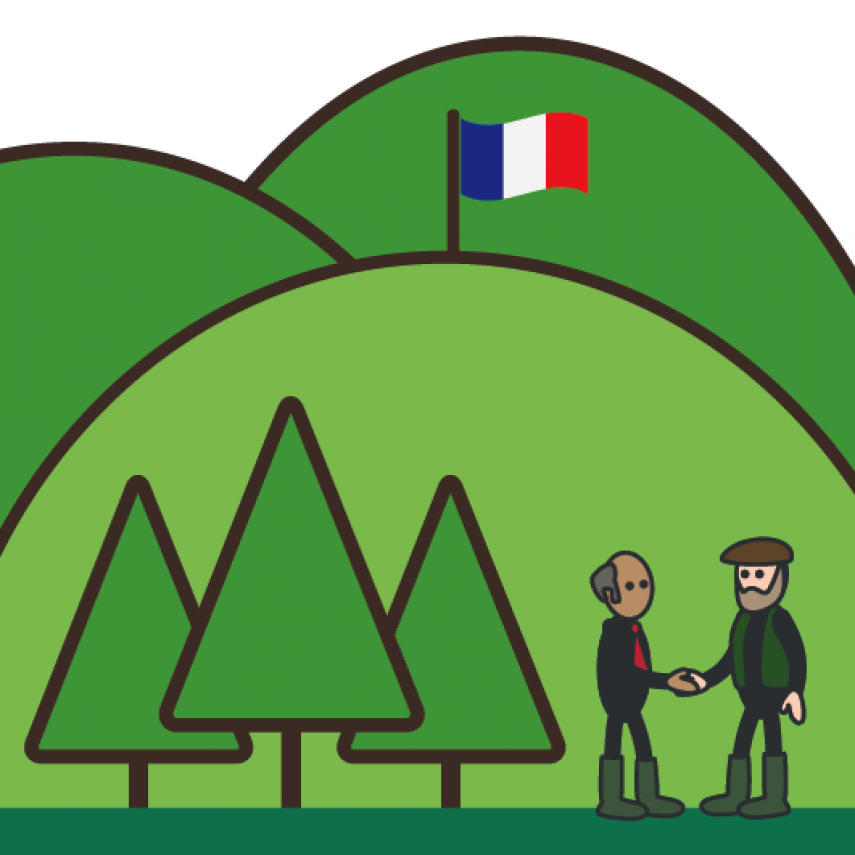France – Municipal management of collective ownership structures
This extract from the full case study gives a flavour of how the forestry system is managed in France. For the complete case study, which delves deeper into the historical background of the system, and contains full academic references, please read the report.
The mechanism(s) of ownership/tenure
In 2012, the ownership of forest land in France was predominantly under private ownership (12.3 million ha; 75% of a total 16.4 million ha), with 10% under state ownership (Forêt domaniale) and 15% owned municipalities (Forêt communale). Within the categories of private and state forest landownership, there are a range of ownership models and governance outcomes.
Across the different regions of France, the balance of private forest ownership varies in comparison to public or communal ownership. Two types of public ownership are of particular interest:
(i) Since 2014 it has been possible for forest owners to create a ‘Forest Economic and Environmental Interest Grouping’ (‘GIEEF’: Groupement d’intérêt économique et environnemental forestier). This was established as a tool to recognise initiatives to make bigger forest units, although without transferring landownership. Where there is joined forest plan, the owners can decide together which plots should be thinned/cleared, thus avoiding heterogeneous management. The groups must be minimum of 300 ha in size, or 100 ha and involve at least 20 people. This type of grouping provides tax relief and enhanced subsidies, opportunities for dialogue and knowledge exchange, as well as economy of scale benefits, for example in hiring forest contractors. For example, forest owners who are members of an officially recognised GIEFF can gain benefits similar to those provided to members of producer organisations under the forest investment tax incentive scheme (‘DEFI’), including a tax credit for the work and contract aspects of the ‘DEFI’ scheme, where they remain a member for the next four years. It is also possible, depending on the regional administration where the GIEEF is located, that these forest grouping entities can benefit from increases in the allocation of public subsidies/aid, whether national or European.
(ii) A specific type of older common from the Massif Central (a ‘Section’) gives authority to the inhabitants of the local hamlet, where they are resident for a minimum of 6 months. Supervision is provided by the ONF, adhering to the rules of the municipality, and providing coordination between all different types of owners.
Extent and process of community control
Within the structures of public sector forest landownership in France, the opportunity arises for local communities to participate in forest land management. The municipal council is elected by local inhabitants; subsequently the municipal council finalises the forest plan, with the technical forest plans created by the forest officer. The Forest Law in 2001 introduced the Charter for Forest Territory (CFT) – a tool created to embed people into decision-making and to discuss forest management at the local/landscape scale. Through the Charter, all local inhabitants and stakeholders are invited to discuss public forest management, seeking to agree a document, recommendations and/or actions, for example, to improve recreation in the forest, create new forest roads, etc. The CFT is considered by key informants as a ‘good tool of governance’, involving active participation of many French forestry/community organisations, and therefore supporting democratic forest ownership. This document also facilitates and regulates tensions in land use planning and forestry regulations, in attempting to organise dialogue between different stakeholders. In reality, however, the main stakeholders who participate in discussions continue to be technical actors, and not citizens. There is a need to generate interest amongst inhabitants to enhance their participation; and in response, the CFT has been elaborated in some regions.
Key challenges and future directions
Forest ownership in France adheres to strong private property rights. Ownership has not been contested since the French Revolution, although the problem of land fragmentation persists. Private forest owners have a lot of power in the Forest Code, and can refuse to participate in the common actions, for example, prioritising timber production and future legacies. Many people now seek forest ownership as an investment, as well as an asset for carbon emissions, fuel, etc. The question arises regarding how well policy will fit with the financialisation of forest land, considering management (i.e. governance), and how communities can collect money from different investors, e.g. banks, carbon investors? What will be the role of the state in forest management in the future? It is suggested that municipal forest owners and the French Forest Office will require a readjustment to their economic model and focus more on timber production. Furthermore, it is noted that forest expertise is not only a public affair and may be considered a new type of market activity (e.g. incorporating private expertise).

